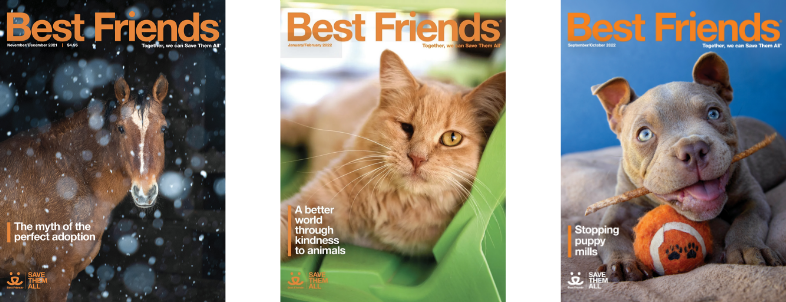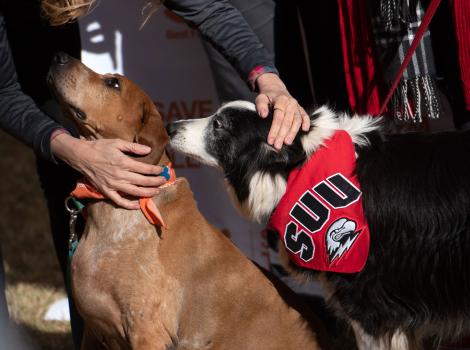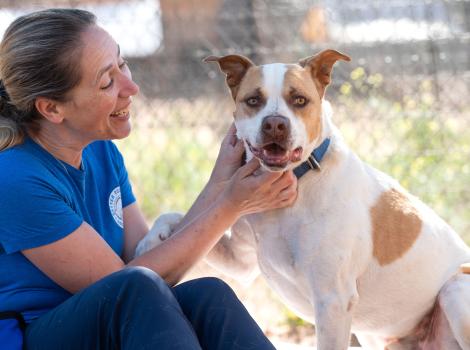Dreamers who do (for animals)
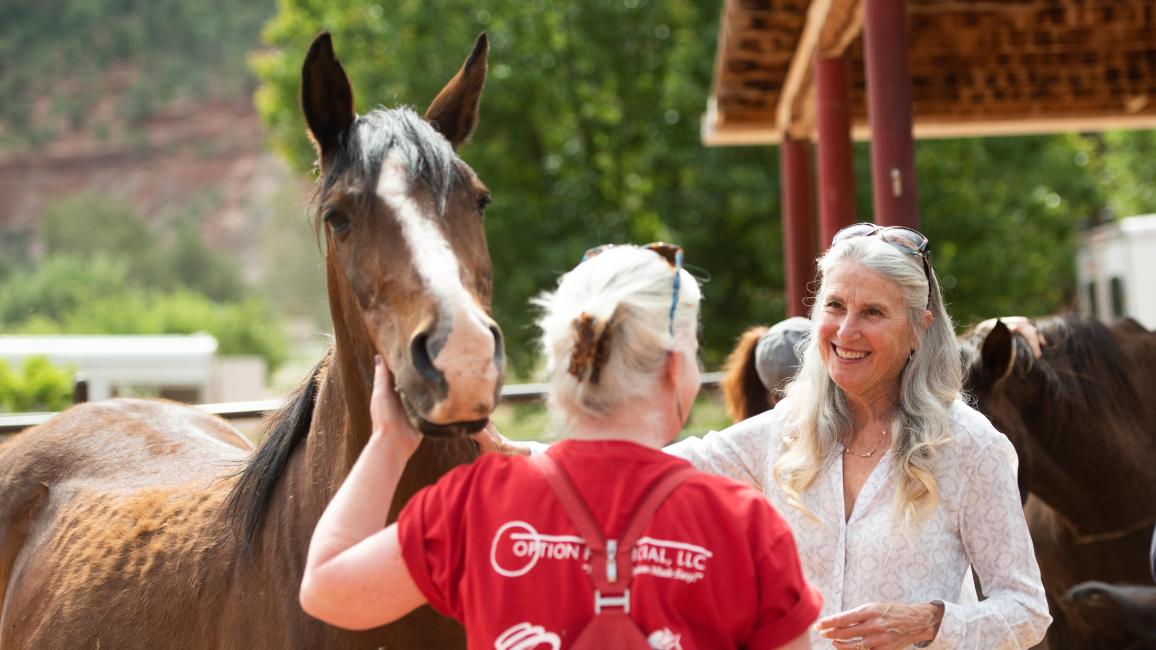
It’s a dream shared by so many animal lovers: saying goodbye to the nine-to-five grind, buying a plot of land, and using it to help animals in need. Does it have to be just a fantasy though? Thanks to a course offered by Best Friends Animal Society for more than a quarter of a century, hundreds of these so-called dreams have been transformed into reality.
Twice a year, dreamers and doers flock to Best Friends Animal Sanctuary in Kanab, Utah, to learn directly from Best Friends founders and other experts about smart strategies to employ — and mistakes to avoid — when starting an animal rescue organization or sanctuary.
“We want anyone who starts a sanctuary to succeed,” says Jana de Peyer, a Best Friends co-founder who has been helping to spearhead the course for nearly 20 years. “We organized it to be a reality check because running a nonprofit is still running a business, and we want people to know that before they even start.”
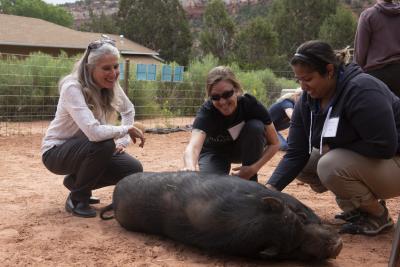
A rich history
Back in 1998, Best Friends co-founders Faith Maloney and Nathania Gartman had a novel idea: invite animal lovers to visit Utah’s stunning Angel Canyon and attend a hands-on, five-day workshop called How to Start and Run an Animal Sanctuary. Admittedly, the part of the course focused on running a sanctuary was added in later years, based on the realization that it’s not enough to simply start one.
“For some time, we had observed people trying to start a sanctuary or an animal rescue group — with little or no basic information,” Faith wrote in 2018. “And many of those people were failing because of that. When that failure happens, the animals suffer.”
The workshop evolved over the years in response to feedback from attendees and other factors. When Nathania died of cancer in 2003, Best Friends co-founder Anne Mejia joined Faith in leading the workshop. Then in 2005, when Anne began focusing on helping homeless pets in New Orleans after Hurricane Katrina, Jana stepped in to help lead the course. “Faith used to say, ‘I’m so embarrassed that we thought we knew enough to tell people how to start a sanctuary,’” Jana recalls with a laugh about the workshop’s earliest years.
[Best Friends-backed degree inspires, guides new animal rescue organization]
From the very beginning, though, the workshop filled a huge need. Attendees devoured information from Best Friends founders and other presenters, and their instruction yielded results. “Even if we stopped some people from starting something that they could not follow through on, that was a victory for the animals,” Faith wrote. “But the workshop also inspired and equipped many others to create many kinds of organizations to help the animals.”
Faith passed away in August 2022, but during her time leading the workshop, she helped more than 1,300 students find their path in animal rescue. Most of the students came from the United States and Canada, but some traveled from as far away as Japan, India, New Zealand, South Africa, Fiji, and the Turks and Caicos Islands. Faith was thrilled to see students start breed-specific rescue groups, spay/neuter programs, and sanctuaries for senior dogs, cats with special needs, parrots, horses, bunnies, pigs, and even former laboratory rats.
After Faith’s death, Best Friends co-founder Silva Battista joined Jana in helping students to learn and thrive. The workshop has continued to expand and evolve in recent years.
Since 2022, it has been offered as an accredited university course called Running a Lifesaving Sanctuary in collaboration with Southern Utah University (SUU). Students who successfully complete the course earn a continuing education credit and can apply for three academic credits from SUU. The three-month hybrid course includes online modules, live weekly Zoom calls, and a six-day, in-person experience at Best Friends Animal Sanctuary, where students can choose from a menu of immersion sessions with different kinds of animals.
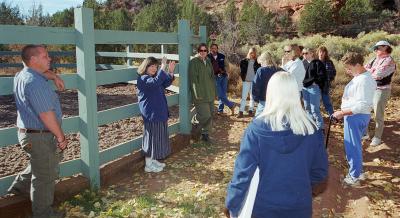
Aha moments abound
Cathie Myers, senior manager of learning advancement for Best Friends, says students often build long-lasting support networks while taking the course. Many of them also experience unexpected flashes of clarity along the way. These aha moments tend to center around the following ideas.
1. It takes a large network of people to rescue animals.
“We work hard to help students understand that you can’t do this by yourself,” Cathie says. “You need people to help you. It’s important to ask: How do I find the right people to create a board of directors for a nonprofit? How do I find volunteers? How do I keep these people engaged?” Jana couldn’t agree more. “Animal rescue really is all about people,” she says. “It’s homes, it’s adoptions, it’s fostering, it’s fundraising. All of that depends on other people. That is sometimes a surprise for our attendees.”
2. Running a sanctuary isn’t the right path for everybody. And that’s OK.
Jana says it’s not uncommon for students in the course to joke that they don’t like people, preferring to spend time with animals. “If you really feel that way, though, you need to find somebody else who can actually run your organization,” Jana says. “We often see the ‘I just want to pet cats’ people, which is great. It might be best for them to help an existing organization instead of starting a new one. The cats will love it!”
3. A sanctuary is supposed to be a temporary haven for animals, not a permanent one.
“With the right behavioral and medical resources, virtually all animals can be rehomed,” Jana says. “If sanctuaries keep them forever, they’re going to fill up pretty quickly and not be able to help any more animals. As Faith used to say, if you’re doing that, you’re just a person with a lot of pets.”
4. Positivity and inclusivity matter.
Cathie says the course instructors encourage students to find ways to say yes. She’s referring to the ultra-strict adoption policies and procedures that rescue groups and sanctuaries sometimes have. “If people are looking to adopt an animal and they’re coming to you, they’re doing the right thing,” Cathie says. “Don’t make it difficult for them to adopt. That pushes people to breeders because otherwise they can’t get an animal. They need to have your support.”
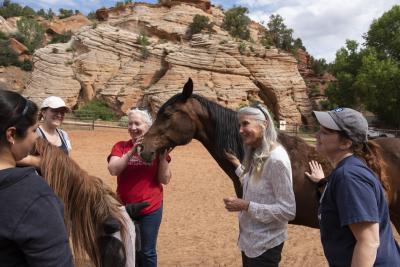
What past students say
Fifteen years ago, Constance Paras was a project manager in the corporate world deploying wireless networks across the country. But she kept dreaming about doing something else with her life. She found a way to do just that when she attended a Best Friends workshop in 2009.
“This workshop is why I changed course in my career and never looked back,” says Constance, who now serves as executive director of the Humane Society of the Tennessee Valley in Knoxville. “Being in nonprofit animal welfare is my calling, and having a reality check at Best Friends before diving in was invaluable. To anyone on the fence about taking the course: Do it. It provides practical knowledge about literally every part of what is needed to start and maintain a lifesaving sanctuary.”
Brenda Koiro, a retired U.S. Air Force officer and a nurse anesthetist, completed the Running a Lifesaving Sanctuary university course in spring 2023. Last August, Brenda and five other dedicated German shepherd rescuers helped launch Shari’s Shepherd Rescue in Las Vegas. “This course came at the perfect time,” Brenda says. “As we were putting together a board, trying to figure out the 501(c)(3) paperwork, working on mission and vision statements, strategic planning, fundraising, how to manage volunteers, and how to take care of the dogs, I was taking this course. Every week for me involved real-time presentations on information we desperately needed.”
[How animal services officers are saving more pets]
And it was all so worth it. “I would absolutely recommend this course to anyone thinking of starting a rescue group,” Brenda advises. “I won’t lie — this course is like drinking from a fire hose, but it covers everything.”
Chris and Angela Fuller-Wigg spent their honeymoon attending the workshop at the Sanctuary in 2018, about 16 months after they started Austin Farm Sanctuary in Texas. “The workshop gave us very valuable insights into animal care but, even more so, organization management,” says Chris, noting that he and Angela went on to expand their operation to care for 215 animals on 95 acres. “We were spared so many difficult ‘learning experiences’ by already having discussed and thought through these.”
Chris credits the experience as being an integral part of the reason they have achieved what they have. “The success story that is Austin Farm Sanctuary would simply not exist if we didn’t start off on the right foot thanks to Best Friends,” he says.
Jana says examples like these inspire her and other instructors to keep helping students. “Best Friends can’t be everywhere, and that’s why it’s important for us to support all these people who really want to do something to help animals in their own communities where there’s a need,” Jana explains. “I tell them they’re our secret weapon to reach no-kill.” The bottom line: It’s crucial that those “secret weapons” never stop dreaming. And never stop doing.
Laura T. Coffey is a longtime journalist and author of the national bestseller My Old Dog: Rescued Pets with Remarkable Second Acts, which features beautiful photographs of senior dogs taken by Best Friends photographer Lori Fusaro.
Running a Lifesaving Sanctuary Certification
The Running a Lifesaving Sanctuary Certification, presented in collaboration with Southern Utah University, is a robust three-month program that provides a gateway to learning the ins and outs of running a successful animal sanctuary.

Participants delve into a range of topics, including the rich history of Best Friends, how to establish a nonprofit organization, effective fundraising strategies, and animal housing essentials. The comprehensive 10-week online curriculum is followed by a six-day immersive session at Best Friends Animal Sanctuary.
The next session begins on June 19 and ends September 14. To learn more and apply, go to bfas.org/RLSC.
This article was originally published in the May/June 2024 issue of Best Friends magazine. Want more good news? Become a member and get stories like this six times a year.
Let's make every shelter and every community no-kill by 2025
Our goal at Best Friends is to support all animal shelters in the U.S. in reaching no-kill by 2025. No-kill means saving every dog and cat in a shelter who can be saved, accounting for community safety and good quality of life for pets.
Shelter staff can’t do it alone. Saving animals in shelters is everyone’s responsibility, and it takes support and participation from the community. No-kill is possible when we work together thoughtfully, honestly, and collaboratively.
